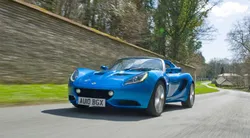

Lotus Elise Generation 2 Facelift 2010 Features
Explore the Lotus Elise and its Generation 2 Facelift 2010. Discover its innovative design and performance enhancements in this iconic sports car.
The Lotus Elise Generation 2, with its facelift in 2010, marked a significant milestone for this iconic sports car. Known for its lightweight design and exceptional handling, the Elise G...
Technical Specifications
Select Version
Dimensions
Engine
Driving
Others
History and Features
Mycarro AI
Feb 1, 2024
Introduction
The Lotus Elise Generation 2, with its facelift in 2010, marked a significant milestone for this iconic sports car. Known for its lightweight design and exceptional handling, the Elise Generation 2 received several updates that enhanced both its performance and aesthetic appeal. In this article, we will explore the key features and improvements of the facelifted Lotus Elise Generation 2.
Design and Exterior
The facelifted Elise Generation 2 received subtle yet noticeable updates to its exterior design. The front end was restyled with a new clamshell bonnet, featuring sharper lines and a revised grille. These changes not only improved aerodynamics but also gave the Elise a more aggressive and modern look. The rear end received similar attention, with redesigned taillights and a new rear diffuser that enhanced the car's overall visual appeal.
Performance and Handling
Underneath its sleek exterior, the Lotus Elise Generation 2 facelift 2010 saw significant improvements in its performance and handling characteristics. The lightweight aluminum chassis remained, ensuring the car's nimble and agile nature. However, the facelift brought about upgrades to the suspension system, resulting in improved handling and a more comfortable ride.
Powering the Elise Generation 2 was a range of four-cylinder engines, offering varying levels of performance. The base model featured a 1.6-liter engine producing 134 horsepower, while higher trim levels boasted a 1.8-liter engine delivering up to 217 horsepower. These powerplants, combined with the car's feather-light weight, enabled the Elise to achieve impressive acceleration and top speed figures.
Interior and Features
Inside the Elise Generation 2, drivers were greeted with a minimalist yet driver-focused cabin. The facelift brought some updates to the interior, including revised seats that provided better support during spirited driving. The dashboard layout remained simple and uncluttered, with the focus placed on the driving experience rather than unnecessary gadgets.
While the Elise Generation 2 stayed true to its lightweight ethos, it didn't compromise on comfort and convenience. Air conditioning, power windows, and a high-quality audio system were optional features that further enhanced the driving experience. Despite being a compact sports car, the Elise offered a surprising amount of storage space, making it suitable for weekend getaways or daily commuting.
Safety and Technology
Lotus Elise Generation 2 prioritized safety alongside performance. The facelifted version featured enhanced safety features such as ABS, traction control, and dual airbags. These additions provided drivers with peace of mind during spirited drives or everyday journeys.
In terms of technology, the Elise Generation 2 facelift 2010 remained relatively unchanged. While it may not have boasted the latest infotainment systems or advanced driver assistance features, the Elise focused on delivering a true driver's experience, free from distractions.
Legacy and Conclusion
The Lotus Elise Generation 2 (facelift 2010) continued the legacy of its predecessors as a purist sports car. Its lightweight design, exceptional handling, and timeless styling made it a favorite among driving enthusiasts. The updates and improvements introduced in the facelift brought the Elise closer to perfection, making it even more desirable to those seeking an exhilarating driving experience.
Whether it was tearing up the curves of a mountain road or enjoying a track day, the Elise Generation 2 delivered thrills at every turn. With its combination of performance, handling, and striking design, the Lotus Elise Generation 2 (facelift 2010) solidified its place as a true classic in the world of sports cars.
